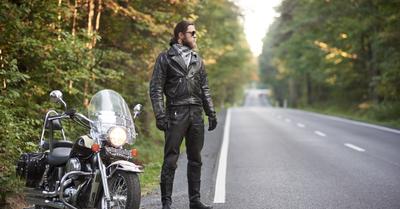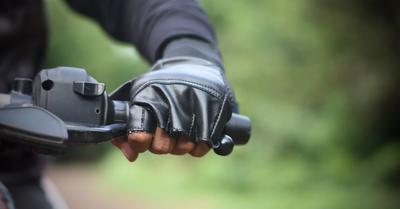Is it Hard to Learn to Ride a Motorcycle?
To put it simply, riding a motorcycle isn't all that hard. The initial learning process of driving or riding any vehicle can be tricky at first. After all, there are many things you need to know. When you first start learning how to ride a motorcycle, you'll need to get accustomed to its weights, controls, and maneuverability. As a first-time rider, it can take you up to eight weeks of daily practice to become a safe motorcyclist.
How Hard is it to Learn to Ride a Motorcycle?
To provide a thorough and comprehensive answer to your question, "is it hard to learn to ride a motorcycle?" - we will need to cover a few topics in detail.
There are quite a few aspects of learning a motorcycle, and just like any other vehicle, some of them are hard to learn, while others are pretty easy. According to Ben, a 27-year-old professional motorcyclist from New Jersey, people who know how to ride a bicycle or drive a manual car will find riding a motorcycle easy. Knowing both or either one of these things will make learning how to ride a motorcycle a lot easier and convenient.
On the other hand, if you don't know either of these things, we can't be too sure of how hard it would be for you to learn to ride a motorcycle. If you're a fast learner with good instincts, you're more likely to pick up things very fast. On the other hand, if you're constantly fearful about riding a motorcycle, it may take you a while to feel comfortable and get acquainted.
Aspects of Learning to Ride a Motorcycle
Let's look at the various aspects of riding a motorcycle that you'll need to learn.
Balancing
Since a motorcycle is set on two wheels, the key is learning how to balance it. So, if you know how to balance a bicycle, you're already halfway there. However, the chief difference between the two is that a motorcycle is much heavier than a bicycle, making it difficult to balance at high speeds. At low speeds, however, balancing a motorcycle is easier than balancing a bicycle.
Understanding Counter-Steer
Counter-steer is the way or technique through which motorcycles steer left and right. It basically entails moving the motorcycle handlebar in the opposite direction of where you want to go. So, in simple words, you have to steer your motorcycle left to lean right, and vice versa. It is critical to fully comprehend the concept of counter-steering and practice it until you're fully ready to perform on the road.
Using a Clutch
If you drive a manual car, you probably already know what a clutch is. In motorcycles, the clutch helps disengage the engine from the drive that turns the wheel. Although motorcycle clutch levels vary from a car's clutch pedal, the instinct or skill required to engage or disengage the clutch at the right time is still the same. Generally, having the know-how of using the clutch of a manual car can make it much easier to understand and handle the clutch of a motorcycle.
Using a Turn-Throttle
Besides scooters and motorcycles, no other vehicles use turn-throttles, so this might be an entirely new and maybe a slightly challenging experience for first-time riders. Most motorcyclists generally view the turn-throttle as a "go-fast" control, which can be opened to go faster and closed to slow down. However, the truth is that the turn-throttle is much more than that, especially a tool that helps your motorcycle's chassis perform better.
The point is that learning how to use the turn-throttle, especially as an amateur rider, might be slightly intimidating at first, but think of it like this: the basic skill of using a throttle combined with the clutch at the right time is the same as managing the clutch and accelerator of a manual car.
Gear Shifting
Unlike automatic transmission vehicles, most motorcycles come with a manual gearbox that is to be operated with the left foot. Gear shifting demands the rider to operate the clutch and throttle with their hands while simultaneously operating the gears with their foot. Experience in handling a manual car can help you comprehend the concept of gear shifting, but the practical application of gear shifting of a motorcycle and car is worlds apart.
Using Brakes
A motorcycle's brakes are very similar to that of a bicycle. The only difference is that the rear brake is operated by a pedal located ahead of the right footpeg. The front brake of a motorcycle is generally located on the right handlebar, just like a bicycle.
Learning Road Safety Rules and Etiquettes
Learning how to ride a motorcycle or any vehicle, for that matter, doesn't just include learning its controls. You will have to learn the basic road rules and etiquette to be a good and responsible rider. If you already know the road rules, that's a plus point since you'll have more time to concentrate on the motorcycle's controls during the learning process.
What are the Most Difficult Things to Learn When Learning to Ride a Motorcycle?
Now that you know the components of learning to ride a bike, it's time to figure out the most difficult things to learn so that you can better focus on them during the learning process. Most experienced motorcycle riders suggest that the most difficult things to learn as a first-time rider are:
- Using a clutch
- Gear shifting
- Understanding countersteer
Using a clutch and shifting gears is easier to understand when you have ample know-how of manual cars. However, you can't deny that the practical application on a car and motorcycle is completely different from one another. Countersteer, on the other hand, is a relatively new concept for those who have never ridden a motorcycle, so it may take a while to get the hang of it.
What are the Easiest Things to Learn When Learning to Ride a Motorcycle?
These might be the easiest things to learn as a first-time motorcycle rider, depending on what you already know:
- Balancing a motorcycle
- Using a turn-throttle
- Applying brakes
- Knowing the road rules
If you know how to ride a bicycle, you probably already know everything you need to know about balancing a motorcycle. Sure, a motorcycle may be heavier than a bicycle, but this basic knowledge will be very helpful for faster learning. A motorcycle's brakes are very similar to that of a bicycle's brakes, so that won't be too hard to learn either.
Turn-throttles are super-easy to learn. Since they aren't used in any vehicles besides scooters and motorcycles, they may seem intimidating at first, but a couple of practice sessions, and you'll become a pro!
If you have a driver's license, you probably already know all the common rules and etiquette, and even if you don't, how long could it possibly take to learn the basic rules via the internet?
Does Age Matter When Learning to Ride a Motorcycle?
Many people wonder if age plays a role in making learning how to ride a motorcycle easier or more difficult. The truth is: age doesn't matter when it comes to learning how to ride a motorcycle!
"I've seen many people belonging to various age groups hop on a motorcycle for the first time and haven't noticed any difference in the learning capabilities of younger and older people. All that really matters is the skills you already have before you start learning how to ride a motorcycle, including the know-how and experience of riding a bicycle, the ability to drive a manual car, and knowledge of the road rules." - James, a 39-year-old experienced motorcycle-rider-turned-motorcycle-teacher.
Arnold, a 25-year-old motorcycle rider from Ohio, agrees with James' statement, adding that every one of the skills mentioned above makes learning to ride a motorcycle much easier and increases your riding skills.
How Long Does it Take to Learn to Ride a Motorcycle?
Again, the time duration it takes to learn how to ride a motorcycle is highly subjective. It mainly boils down to the skill-set you've throughout your lifetime. A 45-year-old with little to no experience of riding bikes and manual cars is more likely to find it more challenging to ride a motorcycle than a 20-year-old who loves riding bicycles and drives a manual car.
Besides this, other factors come into play as well. For instance, a person scared to learn a motorcycle will find it more difficult and may even take longer to learn how to ride on than a person passionate about mastering the art.
Although the time it takes varies from person to person, a new rider should be able to learn how to ride a motorcycle between two to eight weeks of daily practice.
The Risks Involved With Learning to Ride a Motorcycle
It's essential to learn the risks involved in learning how to ride a vehicle, including a motorcycle. Some of the potential risks you face when learning to ride a motorcycle include head-on collisions, rear-end collisions, sliding out, slipping, crashes caused by potholes, and tipping over.
Which Motorcycle to Choose for Learning to Ride a Motorcycle?
There are many good motorcycles that make learning easier, but one of the best ones for first-time riders is the Honda Rebel 500. If you've already gotten a motorcycle, better stick to it unless it's too heavy or big for you.
Gear You Need When Learning to Ride a Motorcycle
You will need basic protection for yourself when learning to ride a motorcycle, so make sure to purchase a good full-face helmet, such as the Bell Qualifier or Fly Racing Street Revolt FS, a solid motorcycle jacket, and proper motorcycle boots.















